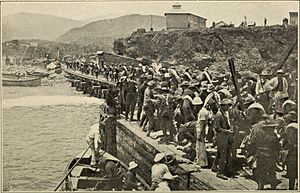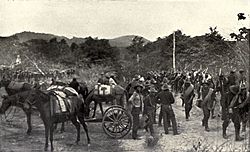Battle of Las Guasimas facts for kids
Quick facts for kids Battle of Las Guasimas |
|||||||
|---|---|---|---|---|---|---|---|
| Part of the Spanish–American War | |||||||
|
|||||||
| Belligerents | |||||||
| Commanders and leaders | |||||||
| Strength | |||||||
| 1,764 1 field gun |
1,500 2 mountain guns |
||||||
| Casualties and losses | |||||||
| 17 killed 52 wounded |
7 killed 14 wounded |
||||||
The Battle of Las Guasimas took place on June 24, 1898. It was the first major land battle of the Spanish–American War. In this fight, Spanish soldiers led by Major General Antero Rubín tried to slow down the advancing American troops. These American forces were led by Major General Joseph Wheeler, also known as "Fighting Joe" Wheeler.
The battle happened near Santiago de Cuba in the jungles. American soldiers, including the famous Rough Riders (1st U.S. Volunteer Cavalry) and the 10th Regular Cavalry, tried to attack the Spanish positions.
Before the battle, American reports said the Spanish were digging in with a large gun. But Cuban scouts, who knew the area well, said the Spanish were actually getting ready to leave. The Spanish troops had orders to move back towards Santiago. General Wheeler wanted to attack right away and asked for help from Cuban forces. However, their commander, Colonel Gonzales Clavel, said no. Wheeler decided to attack anyway, moving his men forward with two field guns.
During the battle, Wheeler's forces tried to surround the Spanish soldiers. They attacked from the front and the right side but were pushed back. Both sides then brought in more soldiers and guns. The Americans attacked again, but the Spanish held their ground.
After stopping the American advance, the Spanish continued their planned retreat towards Santiago. The battle was costly for the U.S. forces, who had 17 soldiers killed and 52 wounded. The Spanish had fewer losses, with 7 killed and 14 wounded. At the time, American newspapers, which often exaggerated news, said the Spanish were completely defeated. Later, historians criticized General Wheeler for sending his men into a direct attack, which cost many lives.
Contents
What Led to the Battle?
On June 23, 1898, Spanish soldiers were moving back from areas where American troops were landing. They met a group of 250 Cuban soldiers near Sevilla, east of Santiago de Cuba. After a small fight, the Spanish moved to a new, lightly dug-in position at Las Guasimas de Sevilla. This spot was on the main road to Santiago.
American commanders thought the Spanish were setting up strong defenses. But Cuban scouts, who were very familiar with the local area, reported that the Spanish were actually getting ready to leave their positions.
General Wheeler received orders to send out scouts to Siboney. He found that the Spanish were retreating towards Sevilla, with about 100 Cuban soldiers fighting their rear guard. Wheeler decided to attack the new Spanish positions the next day. These positions were about three miles from Siboney. With information and a map from General Castillo, Wheeler and General Young planned to advance with two groups of soldiers.
The Battle Begins
The Spanish forces were commanded by Brigadier General Antero Rubín. He had about 1,500 men and 2 guns. These soldiers were placed in three lines of defense. They included different infantry battalions and some engineers with two 75mm Krupp guns.
The American side included the 1st U.S. Volunteer Cavalry, known as the "Rough Riders," led by Leonard Wood. It also included the 1st U.S. Regular Cavalry and the 10th U.S. Regular Cavalry. The 10th Cavalry was made up of African-American soldiers, often called Buffalo Soldiers. With artillery support, the American forces had about 964 men. They were also supported by 800 Cuban soldiers.
The Americans first knew the enemy was close when they saw a dead Cuban soldier on the road. The battle started with shots from U.S. artillery. Spanish soldiers fired back, using their rifles to stop the American advance. The Spanish had very good German-made 7mm 1893 model Mauser rifles. These guns used smokeless gunpowder, which made it very hard for the Americans to see where the shots were coming from. The famous writer Stephen Crane, who was there, said the guns sounded like a musical instrument or a whip.
American Cavalry Attacks
General Wheeler's forces tried to surround the first line of Spanish defense. They attacked from the front and the right side. General SMB Young personally directed a battery of Hotchkiss field guns to fire at the Spanish position. After making sure it was the Spanish, he ordered his troops forward.
The jungle was very thick, and the Spanish used smokeless powder, making it hard to see them. The American soldiers pushed forward bravely. They faced wire fences and steep hills. Despite the tough conditions, the American regular soldiers showed great courage. They did not leave their positions, even to help the wounded. They were very disciplined with their firing. Major Bell, who led a group of soldiers, had his leg broken but kept leading. Captain Knox was shot but continued to give orders. The Americans kept pushing until they could hear the Spanish voices. As they climbed the hills, the Spanish soldiers broke and ran.
Rough Riders Attack on the Left
On the left side, around 7:20 AM, a small group of four Rough Riders found the dead Spanish soldier that the Cubans had warned them about. This meant the Spanish lines were close. When informed, Leonard Wood, who was leading the Rough Riders, ordered silence and sent troops to the left and right. As they were getting into position, a Rough Rider shot a Spaniard, and the Spanish immediately fired back.
The Rough Riders moved forward on both sides of the trail. They eventually forced the Spanish back to their second line of trenches. The Rough Riders kept advancing and eventually made the Spanish leave their final positions completely. By about 9:30 AM, the Rough Riders and regular soldiers had taken the Spanish positions. Reinforcements from the 9th Cavalry arrived, but the main fighting was already over.
After stopping the American advance, the Spanish continued their planned retreat towards Santiago's outer defenses. This allowed the Americans to think their attack had forced the Spanish to retreat, even though the Spanish were already planning to leave.
The Spanish forces reported 7 dead and 7 wounded. However, these numbers are sometimes thought to be higher because the Spanish were also escorting wounded soldiers from earlier fights.
What Happened After the Battle?
Both sides felt they had achieved a "little victory." General Rubín successfully moved his forces away from the powerful naval guns of the U.S. Navy along the coast. He connected with the Spanish defenders of Santiago. For the Americans, this battle was their "first blood" in Cuba. General Wheeler then joined forces with General Calixto García's 5,000 Cuban soldiers and began to surround Santiago's main defenses. American spirits and confidence were very high.
The position the Americans took at Sevilla was not very useful for their main goal of advancing on Santiago. The Spanish retreat, however, opened the way to other strong points protecting Santiago from the east. These included Fort Aguadores, San Juan Hill, Canosa, El Caney, and Fort El Viso. Many bloody battles would happen in these places on July 1. Many Spanish officers and soldiers who fought at Las Guasimas would fight again at the bloody battle of San Juan Hill.
Some U.S. officers criticized Colonel Gonzalez Clavel for not joining the attack. However, he was following military rules and orders from General Lawton, who was in charge of the landing. His actions were approved by General Lawton and General Calixto Garcia. Some historians also believe the Americans made a mistake by attacking head-on. They think the Americans could have gone around the Spanish positions more easily. If the Spanish had decided to stay and fight harder, Wheeler might have suffered a much worse defeat. One Rough Rider officer even said, "It is a good thing we are not at war with England or Germany or France, for we should not last a week."
The way the Spanish placed their troops around Santiago has also been criticized. Some observers said General Linares should have stopped the American landing at Siboney. Others criticized Rubín for giving up the hills at Las Guasimas, even though he had orders to do so. One historian suggested the Spanish could not fight the American advance without being hit by powerful naval guns. However, American naval gunfire was not very effective against land positions during the war, so this idea might not be completely true.
In Movies
The Battle of Las Guasimas was shown in the miniseries Rough Riders, where Tom Berenger played Theodore Roosevelt. The movie shows it as an American victory, but a costly one.
Images for kids
See also
 In Spanish: Batalla de las Guásimas (1898) para niños
In Spanish: Batalla de las Guásimas (1898) para niños





